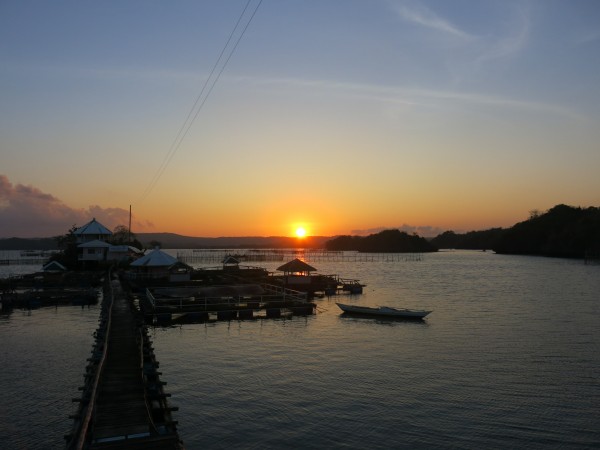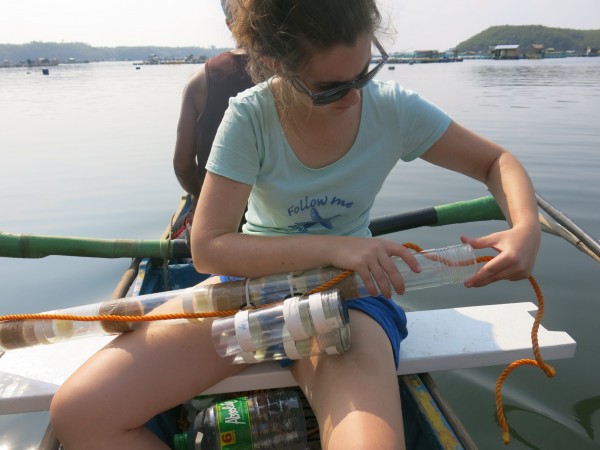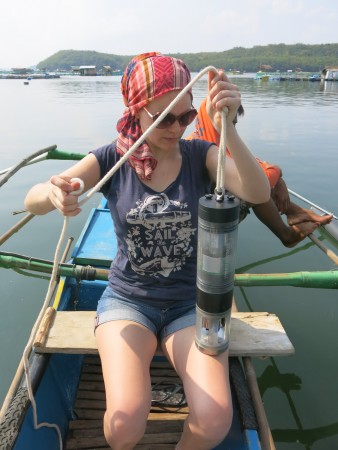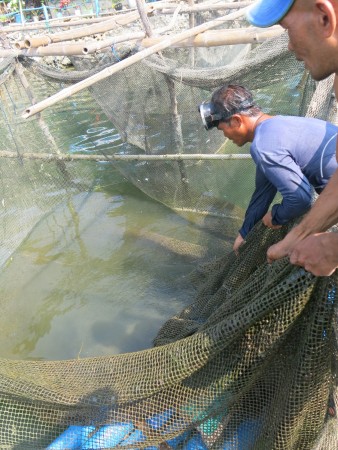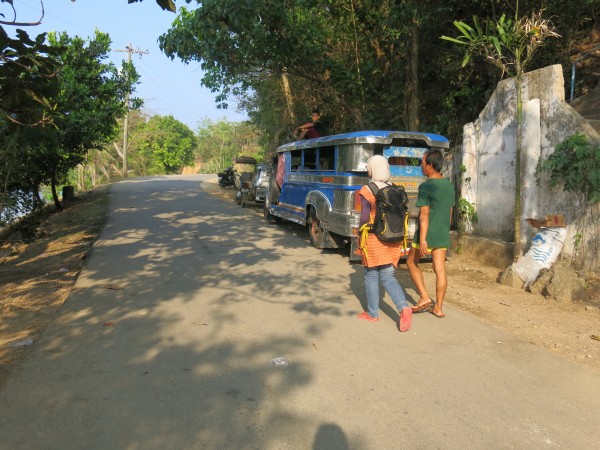Dieser Text ist zur Zeit nur auf Englisch verfügbar...
Marine Aquacultures are an important economic factor in a world that is haunted by overfishing and effects of global warming. Especially coastal communities are affected strongly by dwindling fish stocks, reef destruction and habitat loss. One solution to satisfy the growing need for food is growing the food – i.e. establish ways to produce food independent of classic fisheries while having more control. Of course this is not a flawless solution and eutrophication of marine habitats and increased risk of diseases are just two of the many possible problems. One of the pioneers in marine aquacultures, and especially with inclusion of scientific research, monitoring and suggestions, in the southern pacific is the Bolinao area, where Milkfish (Chanos chanos) are grown in commercial scales just a few hundred meters away from the University of the Philippines (UP) Marine Science Institutes (MSI) Bolinao Marine Laboratory (BML). There, scientists
from the Philippines and all over the world are able to conduct research in marine biology, reef and coastal ecology, oceanography, but especially looking into marine aquacultures and their interplay with the environment. Our working group, the ACUTE-group, a multidisciplinary team of PhD students and researchers from socio-economics, fish biology, biogeochemistry, and marine microbiology, set out for a journey to the Philippines last week (on March the 4th), to meet with scientists from the Philippines and to lay grounds for a cooperation to better understand Milkfish aquacultures, especially the role of marine aggregates in carbon and nutrient fluxes, microbial community composition and dispersal, as well as stress in fish caused by aquaculture practices and the socio-economic driving forces behind those practices, in a more holistic approach, thanks to the multidisciplinarity of our team.
23.3.16
Manila
Since the end of our trip (Rina, Jenny & Inken) to the Philippines is approaching, too, we wanted to take the chance and report about our side of the stay, as well. As Torsten has mentioned before Inken made a trip to IloIlo and Igang to find collaboration partners at SEAFDEC (Southeast Asian Fisheries Development Center). Although it was a bit exhausting to travel for 5 days, it was a great opportunity to talk to some of the researchers at SEAFDEC and to present our project during a seminar. Jenny carried out further experiments using rolling tanks and aggregate traps and has already found differences in the abundances, sizes and the structure of aggregates occurring at different stations (open water, fish cage and pen) in the area of Bolinao. Thanks to Jenny we also received a first impression about the phytoplankton communities at different stations around Bolinao. Rina on the other hand has already visited different Barangays (smallest administrative division) along the coast of Bolinao and on Santiago (small island face to BML) and has had the opportunity to talk to people from the administration of Bolinao and fish cage operators/ fishermen from different Barangays.
As Torsten has already mentioned we mostly used “outside boats” (small fishermen boats) to reach our sampling points. This was arranged by Alfon, one of the boatmen of BML, and thanks to him these trips were always enjoyable and interesting. Alfon used to be a caretaker himself and he turned out to be a great contact person, who happily introduced us to some of his former colleagues. This gave us the great chance to talk to some of the caretakers in Bolinao and to get information about different culture practices. Jenny & Inken could arrange a further trip to one of the milkfish caretakers, who additionally owns a few private small-scale pens for culturing lapu lapu (grouper). This trip was interesting in several ways: we had a first impression about different culture strategies, which includes the culturing of different species (milkfish vs. grouper) and the different production levels (commercial large scale vs. private small scale structures).
In a few hours Jenny & Inken are going to take their flight back to Bremen. Rina will continue her work in the Municipality of Bolinao and Anda until the end of March. To sum up we have really enjoyed our first trip to the Philippines and have already obtained a good first impression regarding the working and environmental conditions at the BML and Bolinao. We hope you enjoyed reading our blog!
Jenny, Rina & Inken
21.3.16
Manila
My stay here in the Philippines is almost over. I left Bolinao on Friday to use the weekend to meet with some Philippine students that will be involved in the project. The week before Easter, the “holy week” is quite a big thing and so time management is not quite as straight forward as I initially hoped. So my report on what is going on in Bolinao will have to mostly rely a bit on witness accounts now - not entirely though.
So let’s see. In my last post Inken had just left for Iloilo and Jenny and I were left in Bolinao doing our fieldwork. Which is exactly what we continued to do until I left on Friday. One important thing to add there (and I know it has been said before) the Manta is a little sensitive to the length of file names too, not only whether or not it uses ASCI characters only. Good thing we had a day spare to make sure we get all our data.
Workwise, it was really the same as what I had already described before. Get one of those tiny, shaky boats; I call her the R/V Hello Kitty (see picture); head out collect the Manta from its 24h logging point and drive around to get some more profiles. Division of labour is crucial on such a tiny vessel. Yet, for some of the work we did, we still decided to spend more time overall but instead have two pairs of eyes focusing on one task only. So we took our profiles, measured our water profiles, and shipped around a little from A to B and back again, and spend the evenings in the overheating laboratory or compiling the already collected data.
And all of a sudden it was already time for me to take my leave from Bolinao, its friendly people, and its not quite so friendly waters (well, what shall I say, I’m a microbiologist, going to places that are in some ways interesting for microorganisms is just part of the job. As it comes, those places are more often than not, not quite those that would be considered incredibly beneficial to human health). So at 4.30 am on Friday my bell rung and I had to grab my suitcase to catch the bus to Manila. First leg of the trip: tricycle ride through the Philippine night – an experience on its own. Next wall to climb: getting the right bus. Which of course didn’t go anymore that day, so instead I had to take the wrong one and then switch busses at some station with a name that I could not possibly understand, let alone remember. Luckily the people working on the bus are incredibly friendly and helpful and dedicated to assist the odd “Americano” (which is what all westerners are referred to and what I heard spoken on the streets a couple of times when we went by).
Said and done, into the bus (which was luckily climatised) and off to Manila. Switch busses half way. This meant switching from an almost empty bus into one that was rather packed, which is twice the fun considering that Philippine busses aren’t quite build for people 1.80m plus, with leg-length adequate for the overall body size. And I guess I do not need to emphasize the “benefits” of Manila city traffic under these circumstances. So the intended 6 hour drive easily turned into an 8.5 and a bit of a journey. Which, all things considered is still not that bad.
Another short *cough* trip on a cab and I am at the hotel, for my strategic meeting with the students on Saturday morning. Meanwhile Inken had returned from Iloilo and went back to Bolinao where she and Jenny will finish up on the fieldwork and head back to Germany in a few days from now. I myself, am outbound tomorrow morning, so today is about packing my things getting some sleep and getting ready to face the jetlag.
15.3.16
Bolinao
And there it happened, my most vital part of equipment went into denial of service....my trusted flip flops broke and I guess I don’t have to emphasize to anyone who has had the pleasure of working in the tropics what that means. Luckily it happened while foraging on the vivid and colorful town’s market and replacement was found easily, a principle that cannot necessarily be applied equally easily when it comes to organizing things more needed to conduct research, such as a UV-lamp for fluorescence microscopes for example. Note to self: next time bring more duct tape and cable ties, and rubber bands…you never know.
Luckily, all of the equipment we brought along is still in perfect working condition and the Manta probe is doing over-hours, feeding us with heaps of data to deal with after long days in the lab and out on the water. Inken, one of the three PhD students accompanying me, left for Iloilo yesterday to meet with potential cooperation partners there, while Febrina, our socio-economics PhD candidate, already left Sunday to Manila, to gather information on aquaculture management. Jennifer, the third of Astrid’s trio infernale (they are doing amazing work really – so I guess a little mockery is in place) remains here with me while we are trying to make sense of the data we got so far and analyze aggregates collected from the water column and grown in the rolling tanks we brought along.
Already we have seen and collected data from several of the sites in the area (each of which would be interesting for ZMT scientist on its own). Among them are a seagrass hatchery, a giant clam hatchery, fish cages, mussel farms, and fish pens. We even got in contact with a very friendly couple living on one of the fish cages taking care of the milkfish (again always including at least one cat and one dog too) who allowed us to monitor water parameters for 24 hours or more, right next to their “living room”.
This of course means, that we have to take one of those slightly adventurous fishing boats they have around here to get there and check up on the probe and change the depth for the next 24 hours. Admittedly, we were more than baffled, when one of the fishermen that took us out took the Niskin bottle in hand while we were preparing the Manta, and set it to work as natural as he would put out a fishing line. Turns out, some of the fishermen around here would make pretty good addition to our team AND are already trained for the job!
10.3.16
Bolinao, Philippines
The first few days of our trip, always apart from the usual traveling time, were spent at the University of the Philippines in Manila. There we met with UP scientists in various stages of their respective careers to find common grounds scientifically and logistically – and I think, quite satisfyingly for all involved parties. An introductory talk about ZMT, presented by Astrid, our Group leader, was followed by a more detailed presentation of the planned research by the PhD students and myself. Followed up by coffee break and Philippine cuisine lunch, scientists from UP took up the microphone to introduce themselves, ask questions, feed us with information, and contribute to our planning. This was followed by smaller discussion rounds where more detailed ideas were exchanged within the work packages.
To name just a few of the very helpful people we would like to thank Prof. Gils S. Jacinto, Prof. Luis Garcia, Prof. Maria Lourdes San Diego-McGlone, Prof. Marie Antonette Juinio-Meñez and Dr. Caroline Jaraula for their contributions, and of course especially our two hosts Dr. Wolfgang Reichert and Prof. Cecilia G. Conaco to whom we are very grateful for helping arrange everything and for the warm welcome and great hospitality.
Our second day in Bolinao was then filled with site scouting, a boat tour through the aquacultures, and a little snorkeling trip at the reef offshore of Bolinao. Admittedly, I wasn’t overwhelmed by what little fish were left there and signs of human influence are omnipresent. The scale of the aquacultures and also the apparent differences between them was equally overwhelming. Basically, on both sides of the narrow channel left for boats to maneuver, we saw everything from simple, almost makeshift bamboo pens and cages floating on an assembly of old barrels, to high end poly-ethylen cages similar to those used all around Europe, e.g. for salmon farming in Scotland.
Our senior staff will travel home now to ZMT, Marum and IBG, and is likely going to be home by the time this here hits the ZMT homepage, while the PhD students and myself will stay here for some more days to get a better overview of the situation and structures and to conduct some pilot measurements. In a nutshell: to get a clear picture of the situation here.
Dr. Torsten Jeske, WG Tropical Marine Microbiology





